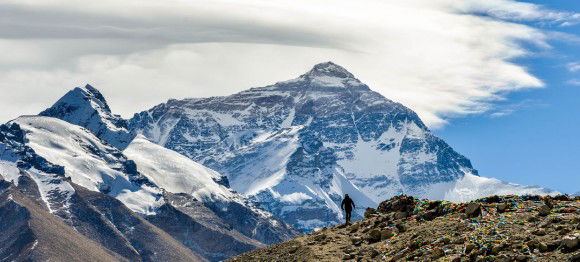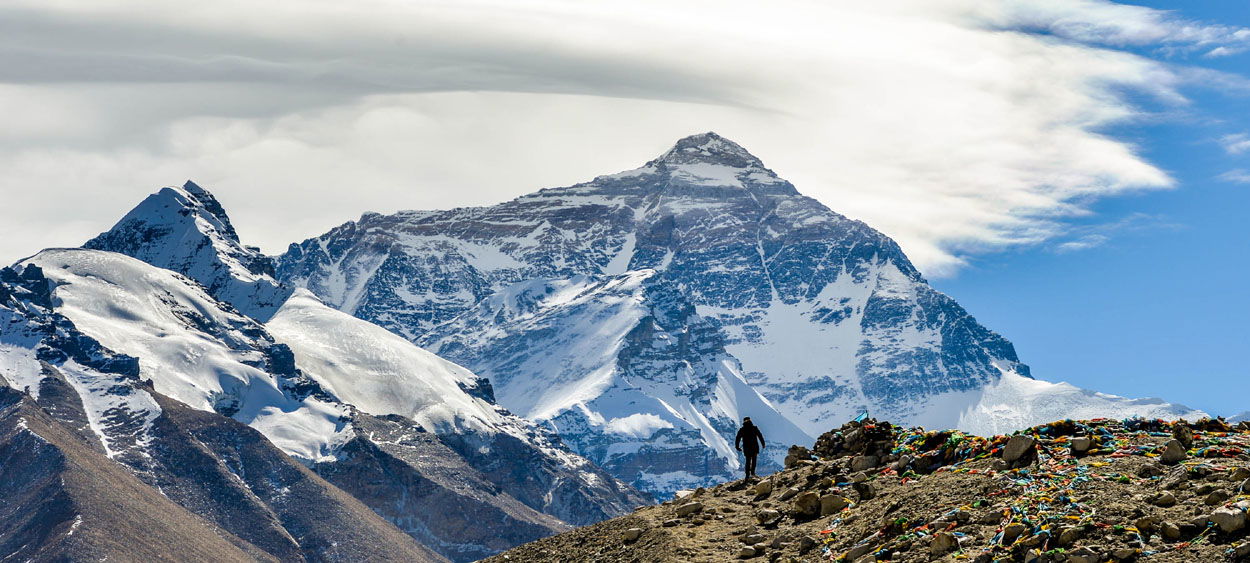Articles features
Post-quake, cracks and holes develop in Mt Everest

Kathmandu, March 26
The world tallest mountain, Everest, has developed several cracks and holes due to the devastating April 25, 2015 earthquake, 'ice-fall' doctors who are installing ropes and aluminum ladders from base camp to top of the mountain have said.
These ice-fall doctors prepare the route from the base camp to the summit, paving the way for climbers to ascend the peak.
Several media reports in Kathmandu said that although a week has passed since the ice-fall doctors began their work, the high-altitude specialists have not yet reached Camp 1 due to difficulties in installing the equipment.
"There are several cracks and holes along the Everest route this year," said Ang Kami Sherpa, adding that tbe earthquake might have caused the cracks. "As a result, we need more aluminum ladders this year compared to previous years to navigate through the cracks and holes."
The climbing season for Everest will being next month, one the most adventurous and dangerous efforts in the world due to a lot of risk that are associated with it.
Khumbu region where the Mt Everest is located, is well-known for difficult ice-pits but due to new cracks and holes this time, ice-fall doctors are facing new challenges in fixing the route.
After 19 climbers and porters were killed in 2014, the remaining had abandoned their expeditions en masse and last year too, there was no expedition to Everest due to the earthquake.
It is difficult to summiyt Everest only after fixing ladders in-between small peaks in between the routes and ice-pits. Nepal has just seven such ice-fall doctors who are trained for fixing the route.
According to the Sagarmatha Pollution Control Committee (SPCC), more than 40 ladders have been installed below Camp 1, and the number could hit 200 by the time the ice- fall doctors reach Camp 2. The SPCC manages the ice-fall doctors and has been launching garbage clearing campaigns on the mountain.
There is a small window for climbing Everest in early May and there is a huge rush of climbers and porters. When the weather is clear, climbers rush to ascend the mountain. At that moment, Everest sees a traffic jam. This time, to avoid overcrowding, the ice-fall doctors are making a two-way route."
"The move is aimed at reducing crowds and ensuring the safety of climbers," said SPCC administrator Nishan Shrestha.
Seven ice-fall doctors have been mobilized to set the spring expedition routes. They said the cracks and holes are less visible after Camp 2.
The SPCC said it would take at least a month for the climbing to begin after the routes are prepared.
"Climbing will probably begin by the first week of May," the SPCC said. Some climbers' groups who have obtained permits have started setting up camps at the Everest Base Camp.
This March, the government extended the climbing permits of hundreds of mountaineers who had been forced to abandon their expeditions last year due to avalanches triggered by the earthquake. The permits have been extended for two years, until 2017.
Last year, 103 teams consisting of 801 individuals had received the permits to climb various peaks in the Himalayas. Among them, 357 mountaineers, including 18 Nepalis, had obtained permits to climb Everest.
(Anil Giri can be contacted at girianil@gmail.com)
These ice-fall doctors prepare the route from the base camp to the summit, paving the way for climbers to ascend the peak.
Several media reports in Kathmandu said that although a week has passed since the ice-fall doctors began their work, the high-altitude specialists have not yet reached Camp 1 due to difficulties in installing the equipment.
"There are several cracks and holes along the Everest route this year," said Ang Kami Sherpa, adding that tbe earthquake might have caused the cracks. "As a result, we need more aluminum ladders this year compared to previous years to navigate through the cracks and holes."
The climbing season for Everest will being next month, one the most adventurous and dangerous efforts in the world due to a lot of risk that are associated with it.
Khumbu region where the Mt Everest is located, is well-known for difficult ice-pits but due to new cracks and holes this time, ice-fall doctors are facing new challenges in fixing the route.
After 19 climbers and porters were killed in 2014, the remaining had abandoned their expeditions en masse and last year too, there was no expedition to Everest due to the earthquake.
It is difficult to summiyt Everest only after fixing ladders in-between small peaks in between the routes and ice-pits. Nepal has just seven such ice-fall doctors who are trained for fixing the route.
According to the Sagarmatha Pollution Control Committee (SPCC), more than 40 ladders have been installed below Camp 1, and the number could hit 200 by the time the ice- fall doctors reach Camp 2. The SPCC manages the ice-fall doctors and has been launching garbage clearing campaigns on the mountain.
There is a small window for climbing Everest in early May and there is a huge rush of climbers and porters. When the weather is clear, climbers rush to ascend the mountain. At that moment, Everest sees a traffic jam. This time, to avoid overcrowding, the ice-fall doctors are making a two-way route."
"The move is aimed at reducing crowds and ensuring the safety of climbers," said SPCC administrator Nishan Shrestha.
Seven ice-fall doctors have been mobilized to set the spring expedition routes. They said the cracks and holes are less visible after Camp 2.
The SPCC said it would take at least a month for the climbing to begin after the routes are prepared.
"Climbing will probably begin by the first week of May," the SPCC said. Some climbers' groups who have obtained permits have started setting up camps at the Everest Base Camp.
This March, the government extended the climbing permits of hundreds of mountaineers who had been forced to abandon their expeditions last year due to avalanches triggered by the earthquake. The permits have been extended for two years, until 2017.
Last year, 103 teams consisting of 801 individuals had received the permits to climb various peaks in the Himalayas. Among them, 357 mountaineers, including 18 Nepalis, had obtained permits to climb Everest.
(Anil Giri can be contacted at girianil@gmail.com)


1 hour ago
New Photo Policy Helps Prevent Immigration Fraud Through Enhanced Identity Verification

1 hour ago
ZEE5 to Stream Kesariya@100, a Docuseries capturing the RSS’ Century-Long Journey

1 hour ago
MoS Pankaj Chaudhary files nomination for Uttar Pradesh BJP chief post

1 hour ago
From Red corridors to rehabilitation: Bastar’s mass surrenders signal fading grip of Naxalism

1 hour ago
Instead of gun in hand, I have hockey stick: Ex-Maoists embrace new beginnings at Bastar Olympics

1 hour ago
Increased FDI limit in insurance to boost innovation, insurance penetration: Industry

1 hour ago
Our shipyards powering PM Modi's vision to make India a top shipbuilder: Minister

1 hour ago
India has potential to become global leader in AI-supported stroke management: Experts

1 hour ago
Future looks bright for ‘very, very talented’ India U19 men’s ahead of next year’s World Cup

1 hour ago
Mandhana congratulates Harmanpreet after PCA unveil stand in her honour

1 hour ago
Mamata Banerjee announces judicial committee to probe chaos at Salt Lake Stadium over Lionel Messi’s visit

1 hour ago
Jackie Shroff honours Smita Patil’s legacy on her 39th death anniversary

1 hour ago
Aditya Dhar says ‘Dhurandhar’ ‘Part 2 is coming’ on Hrithik Roshan's second review






















